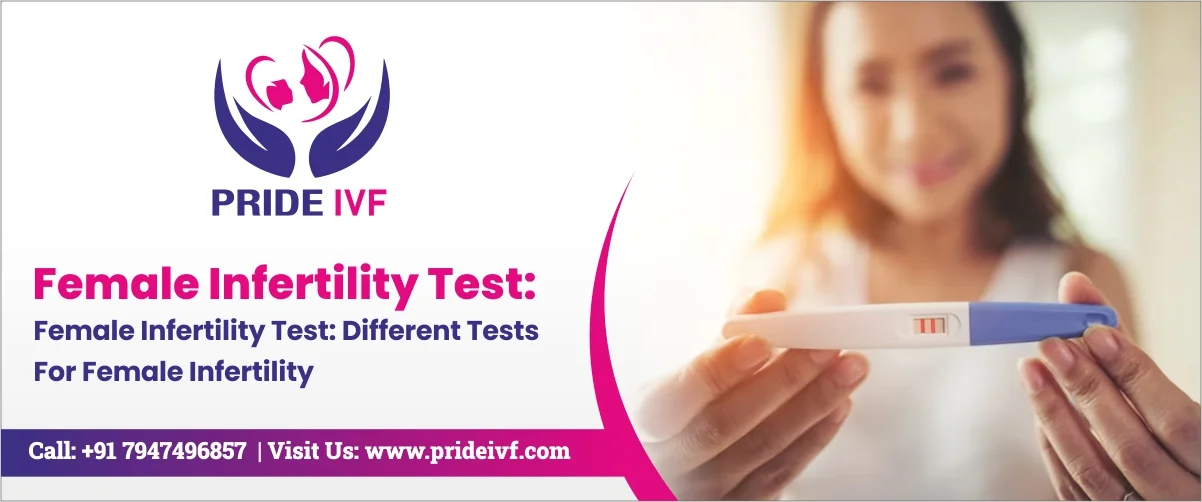#Female infertility tests are essential in the process of becoming a mother since these tests give hope to people who are having difficulty conceiving. These tests act as diagnostic tools, allowing medical professionals to pinpoint the root reasons for infertility and provide personalized treatment regimens.
This blog from the International Pride IVF Centre in Delhi will explore the wide range of tests available for women, from hormonal evaluations to imaging methods and genetic testing. In addition to empowering the women, knowing the significance of a female fertility test is also a key step in realizing the ambition of beginning a family. Discover the significance of female infertility testing with us as we examine their importance to reproductive health.




Hormonal Tests
For the assessment of female infertility, hormonal testing is essential. The delicate hormone balance which is crucial for reproductive health is evaluated. Luteinizing hormone (LH) Test, anti-Müllerian hormone (AMH) Test, and follicle-stimulating hormone (FSH) Test can provide important information.
The functioning of ovaries and the regularity of the menstrual cycle both are affected by FSH and LH levels. While high LH can suggest polycystic ovary disease (PCOD), elevated FSH may indicate a diminished ovarian reserve.
The number of eggs still present in the ovaries is indicated by the ovarian reserve marker AMH. AMH levels below normal may indicate decreased reproductive potential. A crucial first step in resolving infertility is a female fertility test, which assists in identifying hormonal abnormalities and directs the appropriate treatment choices.
Ovulation Tracking
Methods for tracking ovulation are useful tools for evaluating female fertility. Measuring the regular temperature of the body, which rises after ovulation, is known as basal body temperature (BBT) charting. This makes it easier to identify the fertile window.
The ideal timing for conception is detected using ovulation prediction kits (OPKs), which measure the rise in luteinizing hormone (LH) that triggers ovulation.
These techniques help women pinpoint the days when they are most fertile, increasing their chances of having a baby. Ovulation monitoring aids couples in their quest for motherhood and serves as a crucial female infertility test by offering insightful information about the time of ovulation.
Ultrasound Imaging
A basic diagnostic tool for female infertility that provides a non-invasive look at the reproductive system is ultrasound imaging. A tiny probe is inserted into the vagina during a transvaginal ultrasound to get a closer view of the ovaries, uterus, and fallopian tubes. This female infertility test can identify structural problems such as fibroids, ovarian cysts, and anomalies in the uterus.
External pelvic ultrasounds offer a more comprehensive picture of the pelvic area. They help diagnose disorders including polycystic ovaries and gauge uterine lining thickness.
These ultrasound methods assist medical professionals in diagnosing structural problems, evaluating the condition of the reproductive system, and determining the best course of therapy. They are essential in the diagnosis and female infertility treatment and provide insightful information for couples trying to get pregnant.
Hysterosalpingography (HSG)
HSG is a common abbreviation for hysterosalpingography, an essential test for female infertility. It entails a specialized X-ray treatment to assess the uterus and fallopian tubes’ health.
The contrast agent or dye is injected via the cervix into the uterus during HSG. X-ray pictures are captured when the dye passes through the reproductive system. This enables medical professionals to see the uterine cavity and check for anomalies such as fibroids, polyps or structural problems.
For a successful conception, the fallopian tubes must be clear and free of obstruction, which is why HSG also evaluates their patency. Infertility problems may be identified and treated with the use of HSG, which provides insightful information on the condition of the female reproductive organs. Hysterosalpingography Test Price is very reasonable at Pride IVF.
Lets get started
Laparoscopy
Laparoscopy is a flexible technique that may be used to check female infertility for both therapeutic and diagnostic reasons. Small abdominal incisions are made, and a laparoscope—a thin, illuminated tube with a camera—is put through them.
Laparoscopy enables up-close viewing of the organs of the pelvis for diagnostic purposes. When tissue that resembles the uterine lining develops outside the uterus, it can restrict the fallopian tubes and cause discomfort. This is a condition known as endometriosis.
Laparoscopy is also employed for therapeutic reasons. Infertility-related conditions such as fibroids, ovarian cysts, and adhesions (scar tissue) can be removed or treated by surgeons. Compared to standard surgery, this less invasive method often leads to quicker recovery periods and less postoperative discomfort.
Laparoscopy is a crucial female infertility test and it is one of the treatment options that is offered at the International Pride IVF Centre, among other tests. It provides clear diagnostic information and the opportunity for remedial action in a single surgery.
Endometrial Biopsy
Uterus biopsy test is also one of the important female infertility tests. To assess the uterine lining’s propensity for embryo implantation, endometrial biopsy of the uterus are crucial. A little specimen of the endometrium, or lining of the uterus, is taken during this surgery, and it is checked for elements that can prevent successful implantation.
These biopsies aid in the early detection of problems that may prevent embryo attachment, such as endometrial polyps, swelling, or insufficient endometrial thickness. Healthcare professionals can customize fertility treatments to maximize the odds of pregnancy by evaluating the endometrial quality.
Endometrial biopsies are especially useful in situations of repeated miscarriages or unsuccessful IVF cycles because they offer vital information about the uterine environment. They serve as a key test for female infertility and support individualized fertility therapy, increasing the likelihood of conceiving successfully.
Conclusion
A female infertility test is a key stage that provides assurance and hope in the pursuit of children. At the International Pride IVF Centre, we are aware of how important these tests are in identifying the underlying reasons for reproductive problems. We create individualized treatment regimens by detecting hormone imbalances, structural problems, or other contributing causes.
Tests for female infertility and seeking expert assistance can change lives. Couples are given the information they need to make knowledgeable decisions about their reproductive journey in addition to receiving answers. We at the International Pride IVF Centre are prepared to help you along the journey, providing guidance and a sense of optimism as you work towards becoming a parent.
FQAs
Q. How is a woman’s fertility tested?
A woman’s fertility is typically tested through various methods, including a medical history review, physical examination, and specific tests. Doctors may assess hormone levels through blood tests, examine the uterus and ovaries using ultrasound, and conduct tests like hysterosalpingography (HSG) to check for blockages in the fallopian tubes. Additionally, ovulation can be tracked using temperature charts or ovulation predictor kits. These tests help determine the woman’s overall reproductive health and identify any potential issues affecting fertility, enabling healthcare providers to recommend appropriate treatments or interventions.
Q. How do doctors check if a girl is infertile?
To determine if a girl may be infertile, doctors may initially observe her menstrual cycle for irregularities or absence of periods. They may inquire about any previous pregnancies or miscarriages if applicable. Furthermore, they might evaluate lifestyle factors such as nutrition, exercise habits, and exposure to environmental toxins. In some cases, genetic testing may be recommended to identify any inherited conditions that could affect fertility. Additionally, doctors may explore the girl’s reproductive anatomy through non-invasive methods like discussing sexual development and potential issues with menstruation.
Q. What is the test for female infertility profile?
The test for female infertility typically involves a series of examinations and assessments to identify potential causes of infertility. This may include a physical exam, blood tests to check hormone levels, ultrasound to examine the reproductive organs, and tests to assess ovulation and the health of the fallopian tubes and uterus. Additionally, a healthcare provider may recommend further tests such as hysterosalpingography (HSG) to evaluate the condition of the uterus and fallopian tubes or laparoscopy to examine the pelvic organs directly.
Q. How can I test myself for infertility?
To observe for signs of infertility as a woman, you can track your menstrual cycle to ensure it’s regular, which indicates ovulation. Monitor changes in cervical mucus consistency throughout your cycle, as it becomes thin and stretchy around ovulation. Pay attention to any pelvic pain or discomfort, which might signal issues like endometriosis. Also, take note of any irregularities in your periods or any hormonal symptoms like excessive hair growth or acne. These observations can provide insights into your fertility health.
Q. Is fertility test painful?
No, fertility tests for females are typically not painful. They may involve procedures like blood tests to check hormone levels, transvaginal ultrasound to examine the ovaries and uterus, or a hysterosalpingogram (HSG) to check for blockages in the fallopian tubes. While these tests may cause minor discomfort, they are generally well-tolerated. It’s essential to communicate any concerns or anxieties with your healthcare provider, who can offer support and address any discomfort you may experience during the testing process.
Q. What are the 4 causes of female infertility?
Four common causes of female infertility include issues with ovulation (such as irregular menstrual cycles or hormonal imbalances), problems with the fallopian tubes (like blockages preventing eggs from reaching the uterus), conditions affecting the uterus (such as fibroids or polyps), and issues with the ovaries (like premature ovarian failure). These factors can disrupt the normal reproductive process, making it difficult for a woman to conceive naturally. Seeking medical advice can help identify the specific cause and explore appropriate treatment options.




